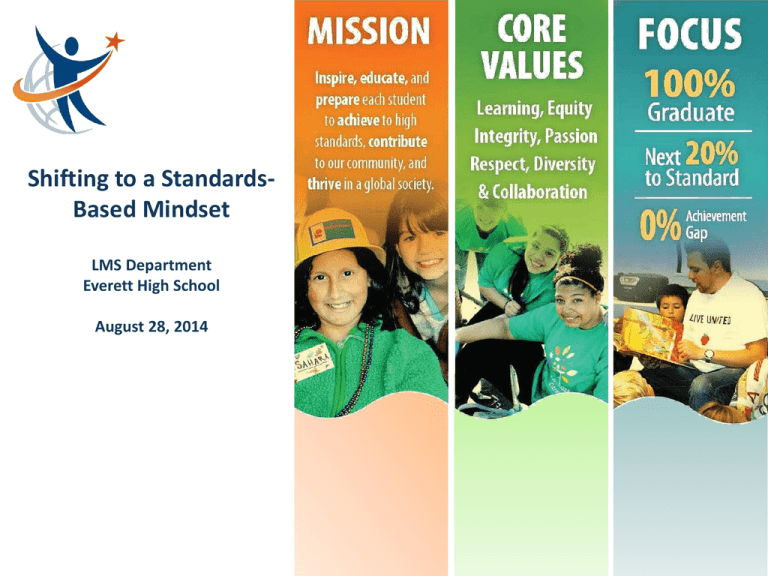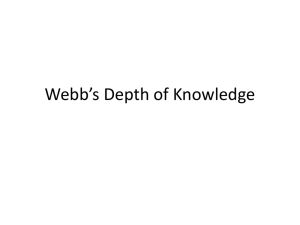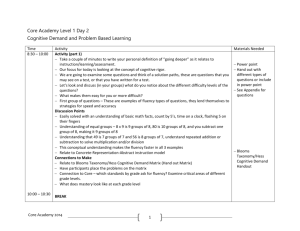EHS Grading Work DOK Training.8.28.2014
advertisement

Shifting to a StandardsBased Mindset LMS Department Everett High School August 28, 2014 Everett High School Current Language Purpose of Grading Statement End of Course Grades (Semester/End of Year): To communicate information about student proficiency on content standards to students, parents, educators and other stakeholders. Formative/Summative Grades: • To provide information to students for self-evaluation • To provide information to classroom/program to inform the next steps of the instruction • Common summative/formative assessments will be used frequently to inform student progress towards standard Schimmer’s Progression Shifting to a Standards-Based Mindset Emphasize COMPLETION or STANDARDS? Is school about ACTIVITIES or LEARNING? Is school about POINTS or EVIDENCE? Is learning an EVENT or a PROCESS? Backwards Design Model Identify/Select Course Standards Common Core, NGSS, WA State, Industry, National Scale Standards Design/Use Common “Leveled” Assessments Instructional Plan/Map Determine Reporting/Grading Variables Develop Interventions/Enrichment Backwards Design Model Identify/Select Course Standards Common Core, NGSS, WA State, Industry, National Scale Standards Design/Use Common “Leveled” Assessments Instructional Plan/Map Determine Reporting/Grading Variables Develop Interventions/Enrichment In Partnership with Curriculum Specialists Proficiency DOK Scaling Leveling Tasks Common Assessments Assessment for Learning Instructional Technology Instructional Maps Grading for Learning Student Unit Plans StudentInvolved Assessment Data Analysis and Reporting Session’s Overview • How is the “Depth of Knowledge” a foundation for a more coherent system for assessment, instruction, curriculum and grading? • What does it mean to focus on standards? • How does restructuring a course help keep Everett’s agreement on the shared purpose for grading? Created based on work of Webb, Norman L. and others. “Web Alignment Tool” 24 July 2005. Wisconsin Center of Educational Research. University of WisconsinMadison. 2 Feb. 2006 Webb’s Depth of Knowledge (DOK) • Addresses the content being assessed and the depth to which we expect students to demonstrate understanding of that content. • Is a reference to the complexity of mental processing that must occur to answer a question, perform a task, or generate a product • Is about cognitive complexity, not difficulty • Is not grade contextualized • Offers a pathway to rigor Norman Webb’s Depth of Knowledge Adapted from the model used by Norm Webb, University of Wisconsin, to align standards with assessments • The degree of depth or complexity of knowledge reflected in the content standards and assessments • How deeply a student needs to understand the content for a given response/assessment Depth of Knowledge depends on more than the verb. The complexity also depends on what the verb is acting on. For example, “draw” is in the DOK level 1 sector. But a student who draws a blueprint of a new building is doing more than recall of information. Explain also can be at different levels--explain by repeating a definition (DOK level 1), explain by putting a paragraph into your own words (DOK level 2), or explain by describing an analysis of the factors contributing to the economic down turn of the US (DOK level 3). DOK Levels 4: Extended Thinking 3: Strategic Thinking 1: Recall 2: Skill /Concept Depth of Knowledge From: Lois Barnes SREB/HSTW • Recall— Identify this utensil. • Concept— Explain the function of the fork. • Strategic— Identify two examples of when a fork would not be the best utensil for a type of food and explain why. • Extended— Design an investigation to determine the optimal number and length of tines for a salad fork. Depth of Knowledge • Recall— Collect data samples over several months. • Concept— Organize the data in a chart. • Strategic— Use the chart to make and justify predictions • Extended— Develop a generalized model from the data and apply it to a new situation. Depth of Knowledge DOK 1 – Student response limited to teacher –specific answer DOK 2 – Student response limited by teacher – strategy options DOK 3 – Student response varies – varied reasoning accepted DOK 4 – Student response variable – options need to be defensible Cognitive Complexity vs Difficulty What is the difference between Cognitive Complexity and Difficulty Level? • Difficulty refers to how many students answered the question correctly. • High Order Thinking refers to how many steps it takes to answer the question. Add: 4,678,895+ 9,578,885 • What is the DOK? Bloom’s and Webb’s Different models to describe cognitive rigor • Bloom – What type of thinking (verbs) are needed to complete the task? • Webb – How deeply do you have to understand the content to successfully interact at a given depth? How complex is the content? Cognitive Rigor Matrix This matrix from the Smarter Balanced Content Specifications for Mathematics draws from both Bloom’s (revised) Taxonomy of Educational Objectives and Webb’s Depth-of-Knowledge Levels below. DOK Snapshot • DOK is a scale of cognitive demand • DOK is about the item/standard not the student • DOK is not about difficulty but how much content knowledge is required within the thinking student need to do to complete the prompt/task • The context of the item/standard must be considered to determine the DOK level not just a look at what verb was chosen. – DOK is lowered when too much information is given • DOK is not an exact science How can we be consistent in applying DOK for a given course? Depth of Knowledge = Cognitive Demand = Rigor • How much and what kind of “thinking” is called for in each set of standards (cluster, PE, ELAR)? • What tasks and contexts will students need to demonstrate proficiency? • What kinds of “thinking” is called for approaching the standard and advancing beyond? Proficiency Scaling The process of identifying and developing the cognitive demand or level of rigor for a given standard. - Starting with the standard: educators use a framework … (Webb’s DOK) …as way to build “a rigorous rubric-based approach in the interest of valid and reliable assessing” which informs both teacher and student - If Proficient is the standard: - What is Advanced? - What is a Basic? Marzano, Robert J. Formative Assessment and Standards-Based Grading 2010 Advanced Cognitive task extending from standard; requiring decision-making, expressing reasoning, or applying what has been explicitly taught in new contexts Proficient Standard as defined by the state including expectations for content, process, skills, and/or performance to be explicitly taught. Basic Cognitive step just before standard that is explicitly taught; includes concepts broken into distinct segments, foundational skills and key vocabulary. Foundational Various cognitive steps before Basic Proficiency Skills/ Concepts DOK 2 Extended Thinking DOK 4 Recall/ Reproduction DOK 1 Strategic Thinking DOK 3 Proficiency Scale level does not equal DOK level Determining DOK • How would you describe the progression from 1st grade to 4th grade? • As a small group discuss and have one member record what each standard’s DOK level might be and provide a rationale for your thinking. • Include any questions your discussion raised or disagreements you encountered. Clarifying Course Standards District teams drafted Grades 6-12 ELA Reading and Writing, U.S. History, World History, Algebra II, Geometry, Algebra 1, Grades 6-8 Mathematics, Algebra 1, Geometry, Algebra II, K-8 NGSS Science, Coordinated Science, Biology, Chemistry Advanced Cognitive task extending from standard; requiring decision-making, expressing reasoning, or applying what has been explicitly taught in new contexts Proficient Standard as defined by the state including expectations for content, process, skills, and/or performance to be explicitly taught. Basic Foundational Cognitive step just before standard that is explicitly taught; includes concepts broken into distinct segments, foundational skills and key vocabulary. Various cognitive steps before Basic K-Math Advanced Proficient Standard as defined by the state including expectations for content, process, skills, and/or performance to be explicitly taught. Know number names and the count sequence. (MTH.K.CC.KNNCS) Count to 100 by ones (MTH.K.CC.KNNCS.1) Count to 100 by tens (MTH.K.CC.KNNCS.1) Count forward beginning from a given number within the known sequence (instead of having to begin at 1). (MTH.K.CC.KNNCS.2) Write numbers from 0 to 20. (MTH.K.CC.KNNCS.2) Represent a number of objects with a written numeral 0-20 (with 0 representing a count of no objects). (MTH.K.CC.KNNCS.3) Basic Foundational Various cognitive steps before Basic K-Math Advanced Proficient Standard as defined by the state including expectations for content, process, skills, and/or performance to be explicitly taught. Know number names and the count sequence. (MTH.K.CC.KNNCS) Count to 100 by ones (MTH.K.CC.KNNCS.1) Count to 100 by tens (MTH.K.CC.KNNCS.1) Count forward beginning from a given number within the known sequence (instead of having to begin at 1). (MTH.K.CC.KNNCS.2) Write numbers from 0 to 20. (MTH.K.CC.KNNCS.2) Represent a number of objects with a written numeral 0-20 (with 0 representing a count of no objects). (MTH.K.CC.KNNCS.3) Basic Cognitive step just before standard that is explicitly taught; includes concepts broken into distinct segments, foundational skills and key vocabulary Uses the pattern of 1-9 to count within a decade (e.g. in twenties, in thirties, etc) Writes numbers from 0 to 20 using a tool (e.g. number line, 100s chart) Represents a number of objects with a visual tool 0-20 (refer to a number line or number card). Recognizes the numbers from 0 to 20. Foundational Various cognitive steps before Basic K-Math Advanced Cognitive task extending from standard; requiring decision-making, expressing reasoning, or applying what has been explicitly taught in new contexts Count backwards from a given number by ones. Write numbers from various starting points beyond 20 and continue the number pattern. Write given numbers out of sequence above 20. Proficient Standard as defined by the state including expectations for content, process, skills, and/or performance to be explicitly taught. Know number names and the count sequence. (MTH.K.CC.KNNCS) Count to 100 by ones (MTH.K.CC.KNNCS.1) Count to 100 by tens (MTH.K.CC.KNNCS.1) Count forward beginning from a given number within the known sequence (instead of having to begin at 1). (MTH.K.CC.KNNCS.2) Write numbers from 0 to 20. (MTH.K.CC.KNNCS.2) Represent a number of objects with a written numeral 0-20 (with 0 representing a count of no objects). (MTH.K.CC.KNNCS.3) Basic Cognitive step just before standard that is explicitly taught; includes concepts broken into distinct segments, foundational skills and key vocabulary Uses the pattern of 1-9 to count within a decade (e.g. in twenties, in thirties, etc) Writes numbers from 0 to 20 using a tool (e.g. number line, 100s chart) Represents a number of objects with a visual tool 0-20 (refer to a number line or number card). Recognizes the numbers from 0 to 20. Foundational Various cognitive steps before Basic Advanced Cognitive task extending from standard; requiring decision-making, expressing reasoning, or applying what has been explicitly taught in new contexts Proficient Standard as defined by the state including expectations for content, process, skills, and/or performance to be explicitly taught. Basic Cognitive step just before standard that is explicitly taught; includes concepts broken into distinct segments, foundational skills and key vocabulary. Foundational Various cognitive steps before Basic Difference Between Scales and Rubrics • Scales are built for teachers use in planning assessments and instruction • Scales are tied to standard – independent of performance task • Basic tasks are deliberate performance expectations not written to be “lacking” or “missing” proficient elements • Rubrics are tied to specific performance expectations – Rubrics are smaller picture – Proficiency Scales are the bigger picture Leveraging Scaling Rigorous, Informative Assessment Scaling and Leveling Curriculum & Instruction Reporting Variables/ Grading Practices 35 Clarifying Course Standards Cognitive demand and learning progression Determine sequencing of standards Course Overview • What will be measured, when and to what level • Specific to unit • Specific to lesson Session’s Overview • How is the “Depth of Knowledge” a foundation for a more coherent system for assessment, instruction, curriculum and grading? • What does it mean to focus on standards? • How does restructuring a course help keep Everett’s agreement on the shared purpose for grading? In Partnership with Curriculum Specialists Proficiency DOK Scaling Leveling Tasks Common Assessments Assessment for Learning Instructional Technology Instructional Maps Grading for Learning Student Unit Plans StudentInvolved Assessment Data Analysis and Reporting Schimmer’s Key Questions Emphasize COMPLETION or STANDARDS? Is school about ACTIVITIES or LEARNING? Is school about POINTS or EVIDENCE? Is learning an EVENT or a PROCESS? Everett High School Current Language Purpose of Grading Statement End of Course Grades (Semester/End of Year): To communicate information about student proficiency on content standards to students, parents, educators and other stakeholders. Formative/Summative Grades: • To provide information to students for self-evaluation • To provide information to classroom/program to inform the next steps of the instruction • Common summative/formative assessments will be used frequently to inform student progress towards standard Welcome, Encourage, Inspire to Build Confident Learners








